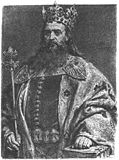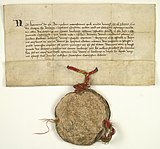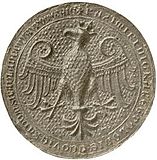Casimir III the Great
| Casimir III the Great | |
|---|---|
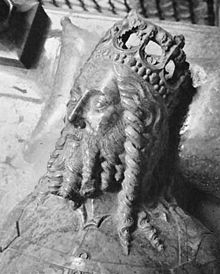 Casimir's tomb effigy inWawel | |
| King of Poland | |
| Reign | 1333–1370 |
| Coronation | 25 April 1333 |
| Predecessor | Ladislaus the Short |
| Successor | Louis I of Hungary |
| King of Ruthenia | |
| Reign | 1340–1370 |
| Predecessor | Yuri II of Galicia |
| Successor | Louis I of Hungary |
| Born | 30 April 1310 Kowal,Duchy of Brześć Kujawski |
| Died | 5 November 1370(aged 60) Kraków,Poland |
| Burial | Wawel Cathedral,Kraków |
| Spouse | Aldona of Lithuania Adelaide of Hesse Christina Rokiczana(morganatic) Hedwig of Sagan |
| Issue more... | Elisabeth, Duchess of Pomerania Anna, Countess of Cilli |
| House | Piast |
| Father | Władysław I Łokietek |
| Mother | Jadwiga of Kalisz |
| Signature |  |
Casimir III the Great(Polish:Kazimierz III Wielki;30 April 1310 – 5 November 1370) reigned as theKing of Polandfrom 1333 to 1370. He also later becameKing of Rutheniain 1340, and fought to retain the title in theGalicia-Volhynia Wars.He was the last Polish king from thePiast dynasty.
Casimir inherited a kingdom weakened by war and under his rule it became relatively prosperous and wealthy. He reformed the Polish army and doubled the size of the kingdom. He reformed the judicial system and introduced several undying codified statutes, gaining the title "the PolishJustinian".[1]Casimir built extensively and founded theJagiellonian University(back then simply called the University of Krakow),[2]the oldestPolish universityandone of the oldest in the world.He also confirmed privileges and protections previously granted toJewsand encouraged them to settle in Poland in great numbers.[3]
Casimir left no legitimate sons. When he died in 1370 from an injury received while hunting, his nephew, KingLouis I of Hungary,succeeded him as king of Poland inpersonal union with Hungary.
The Great King
[edit]
Casimir was born on 30 April 1310 inKowal,Kuyavia,[4]the third son ofLadislaus the ShortandJadwiga of Kalisz.[5]He had two brothers who died in infancy and three sisters: Kunegunda, Elżbieta, and Jadwiga.[4]When Casimir attained the throne in 1333, his position was in danger, as his neighbours did not recognise his title and instead called him "king ofKraków".The kingdom was depopulated and exhausted by war, and the economy was ruined. In 1335, in theTreaty of Trentschin,Casimir was forced to relinquish his claims toSilesia"in perpetuity".
Casimir began to rebuild the country and strengthen its defenses. During his reign, nearly 30 towns were supplied with fortification walls and some 50 castles were constructed, including castles along theTrail of the Eagle's Nests.These achievements are still celebrated today, in a commonly-known ditty that translates as follows:inherited wooden towns and left them fortified with stone and brick(Kazimierz Wielki zastał Polskę drewnianą, a zostawił murowaną).[6]
He organized ameeting of kings in Krakówin 1364 at which he exhibited the wealth of the Polish kingdom.[7]Casimir is the only king in Polish history to both receive and retain the title of "Great", asBolesław Iis more commonly known as "the Brave".[8]
Reforms
[edit]Casimir ensured stability and great prospects for the future of the country. He established the Corona Regni Poloniae – the Crown of the Polish Kingdom,[6]which certified the existence of the Polish lands independently from the monarch. Prior to that, the lands were only the property of thePiast dynasty.
At theSejminWiślica,on 11 March 1347, Casimir introduced reforms to the Polish judicial system and sanctionedcivilandcriminalcodes for Great and Lesser Poland, earning the title "the Polish Justinian".[1]In 1364, having received permission from Pope Urban V, Casimir established theUniversity of Kraków,now the oldest university in Poland.[9]It was regarded as a rare distinction, since it was only the second university founded in Central Europe, after the Charles University in Prague.[6]
Politics and expansion
[edit]Casimir demonstrated competence in foreign diplomacy and managed to double the size of his kingdom. He neutralized relations with potential enemies to the west and north, and began to expand his territory eastward. He conquered the Ruthenian kingdom ofHalychand Volodymyr (a territory in the modern-dayUkraine), known in Polish history as Red Ruthenia and Volhynia. By extending the borders far south-east, the Polish kingdom gained access to the lucrative Black Sea trade.[10]
Succession
[edit]In 1355, inBuda,Casimir designated his nephewLouis I of Hungaryas his successor should he produce no male heir, just as his father had withCharles I of Hungaryto gain help against Bohemia. In exchange Casimir gained a favourable Hungarian attitude, needed in disputes with the hostile Teutonic Order and theKingdom of Bohemia.At the time Casimir was 45 years old, and so producing a son did not seem unreasonable.[11]
Casimir left no legal son, however, begetting five daughters instead. He tried to adopt his grandson,Casimir IV, Duke of Pomerania,in his last will. The child had been born to his eldest daughter,Elisabeth, Duchess of Pomerania,in 1351. This part of the testament was invalidated by Louis I of Hungary, however, who had traveled toKrakówquickly after Casimir died (in 1370) and bribed the nobles with future privileges. Casimir III also had a son-in-law,Louis VIof Bavaria,MargraveandPrince-electorofBrandenburg,who was considered a possible successor, but he was deemed ineligible as his wife, Casimir's daughter Cunigunde, had died in 1357 without issue.[12]
Thus King Louis I of Hungary became successor in Poland. Louis was proclaimed king upon Casimir's death in 1370, though Casimir's sister Elisabeth (Louis's mother) held much of the real power until her death in 1380.[13]
Society under the reign of Casimir
[edit]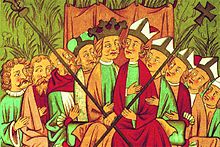
Casimir was facetiously named "the Peasants' King". He introduced the codes of law of Greater and Lesser Poland as an attempt to end the overwhelming superiority of the nobility. During his reign all three major classes — the nobility, priesthood, and bourgeoisie — were more or less counterbalanced, allowing Casimir to strengthen his monarchic position. He was known for siding with the weak when the law did not protect them from nobles and clergymen. He reportedly even supported a peasant whose house had been demolished by his own mistress, after she had ordered it to be pulled down because it disturbed her enjoyment of the beautiful landscape.[citation needed]
His popularity with the peasants helped to rebuild the country, as part of the reconstruction program was funded by a land tax paid by the lower social class.[6]
Relationship with Jews
[edit]
On 9 October 1334, Casimir confirmed the privileges granted to Jews in 1264 byBolesław V the Chaste.Underpenalty of death,he prohibited the kidnapping of Jewish children for the purpose of enforcedChristianbaptism,and he inflicted heavy punishment for the desecration of Jewish cemeteries. While Jews had lived in Poland since before his reign, Casimir allowed them to settle in Poland in great numbers and protected them aspeople of the king.About 70 percent of the world's European Jews, orAshkenazi,can trace their ancestry to Poland due to Casimir's reforms.[14]Casimir's legendary Jewish mistressEsterkaremains unconfirmed by direct historical evidence.[15]
Relationships and children
[edit]Casimir III was married four times:
Aldona of Lithuania
[edit]On 30 April or 16 October 1325, Casimir marriedAldona of Lithuania,[a][17]daughter of Grand DukeGediminas of Lithuania[18]andJewna.They had:
- Elisabeth of Poland(ca. 1326–1361); married DukeBogislaus V of Pomerania[19]
- Cunigunde of Poland (1334–1357),[19]marriedLouis VI the Roman,the son ofLouis IV, Holy Roman Emperor
- Anna[19]
Aldona died on 26 May 1339. Casimir remained a widower for two years.
Adelaide of Hesse
[edit]On 29 September 1341, Casimir married his second wife,Adelaide of Hesse.She was a daughter ofHenry II, Landgrave of Hesse,and Elizabeth of Meissen. They had no children. Casimir started living separately from Adelaide soon after the marriage. Their loveless marriage lasted until 1356, when he declared himself divorced.[20]
Christina Rokiczana
[edit]After Casimir "divorced" Adelaide he married his mistressChristina Rokiczana,the widow of Miklusz Rokiczani, a wealthy merchant. Her own origins are unknown. Following the death of her first husband she had entered the court ofBohemiainPragueas alady-in-waiting.Casimir brought her with him from Prague and convinced the abbot of theBenedictineabbeyofTyniecto marry them. The marriage was held in a secret ceremony but soon became known. Queen Adelaide renounced it asbigamousand returned to Hesse. Casimir continued living with Christine despite complaints byPope Innocent VIon behalf of Queen Adelaide. This marriage lasted until 1363–64 when Casimir again declared himself divorced. They had no children.[21]
Hedwig of Żagań
[edit]In about 1365, Casimir married his fourth wifeHedwig of Żagań.She was a daughter ofHenry V of Iron,Duke ofŻagańand Anna of Mazovia. They had three children:
- Anna of Poland, Countess of Celje(1366 – 9 June 1422); married firstlyWilliam of Celje;their only daughter wasAnne of Celje,who marriedJogaila of Lithuaniawhen he was king of Poland (as Władysław II Jagiełło). Anna married secondly Ulrich,Duke of Teck;they had no children.
- Kunigunde of Poland (1367 – 1370)
- Jadwiga of Poland (1368 – ca. 1382)
As Adelheid was still alive (and possibly Christina as well), the marriage to Hedwig was also considered bigamous. Because of this, the legitimacy of his three young daughters was disputed.[22]Casimir managed to have Anna and Kunigunde legitimated byPope Urban Von 5 December 1369. Jadwiga the younger was legitimated byPope Gregory XIon 11 October 1371 (after Casimir's death).[23]
Title and style
[edit]Casimir's full title was:Casimir by the grace of God king ofPolandandRus'(Ruthenia), lord and heir of the land ofKraków,Sandomierz,Sieradz,Łęczyca,Kuyavia,Pomerania (Pomerelia).The title in Latin was:Kazimirus, Dei gratia rex Polonie et Russie, nec non Cracovie, Sandomirie, Siradie, Lancicie, Cuiavie, et Pomeranieque Terrarum et Ducatuum Dominus et Heres.[24]
Popular culture
[edit]Film
[edit]- Casimir III the Great is one of the main characters in Polish historical drama seriesKorona królów(The Crown of the Kings). He is played by Mateusz Król (season 1) and Andrzej Hausner (season 2).[25]
- Casimir III the Great is mentioned in a speech byAmon Göthin the filmSchindler's List.[26]
Video games
[edit]- Casimir features as a playable leader in the 2010 strategy gameCivilization V,having been added in its 2013 expansion, Brave New World.
- Casimir also features as a ruler in the strategy gameCrusader Kings II.
Currency
[edit]- Casimir is featured on the obverse of the 50Polish złotybanknote,with his regalia on the reverse.[27]
Gallery
[edit]-
Casimir III the Great byJan Matejko
-
Casimir the Great byLeopold Loeffler
-
Casimir III's tomb atWawel Cathedral
-
Document issued by Casimir the Great granting theArmenian bishopGregory (Գրիգոր) the right to stay and preach inLviv,1367
-
Royal seal, 1334
See also
[edit]- History of Poland (966–1385)
- Jagiellonian University
- Kazimierz Wielki University in Bydgoszcz
- Congress of Kraków
- Kazimierz
- Kazimierz Dolny
- List of PolesandPoulaines
- Esterka
Notes
[edit]References
[edit]- ^abSaxton, L. C. (1851).Fall of Poland; containing an analytical and a philosophical account of the causes which conspired in the ruin of that nation; together with a history of the country from its origin, in two volumes.Vol. I. New York: Charles Scribner publishing company. pp.89.
- ^Saxton, 1851, p. 535
- ^Aharoni, Yohanan (2006-09-15).The Jewish People: An Illustrated History.A&C Black. p. 220.ISBN978-0-8264-1886-9.
- ^ab"Kazimierz III Wielki (1310–1370)".Retrieved28 March2020.
- ^Lerski 1996,p. 249–250.
- ^abcdDobrawski, Patrice M. (2016).Poland: The First Thousand Years.Illinois: Northern Illinois University Press. p. 37.ISBN978-0-87580-756-0.
- ^Nowakowska, Natalia (2007).Church, State and Dynasty in Renaissance Poland: The Career of Cardinal Fryderyk Jagiellon (1468-1503).Ashgate Publishing, Ltd. p. 13.ISBN9780754656449.
- ^"Czy Kazimierz Wielki zasłużenie nosi przydomek" wielki "? Argumenty za".Retrieved29 March2020.
- ^Ness, Daniel; Lin, Chia-Ling (2015).International Education: An Encyclopedia of Contemporary Issues and Systems.Routledge. p. 569.ISBN9781317467519.
- ^Dobrawski, Partice M. (2016).Poland: The First Thousand Years.Illinois: Northern Illinois University Press. p. 35.ISBN978-0-87580-756-0.
- ^"Władca, który zasłużył na swój przydomek. Dziś rocznica śmierci Kazimierza Wielkiego".Retrieved28 March2020.
- ^"Kunegunda, córka Kazimierza Wielkiego: nieszczęśliwa panna młoda".Retrieved29 March2020.
- ^Lukowski, Jerzy; Zawadzki, Hubert (2016) [2001].A concise history of Poland.Cambridge University Press. pp.34.ISBN9780521853323.
- ^"In Poland, a Jewish Revival Thrives—Minus Jews".The New York Times.12 July 2007.
- ^"Esterka: między legendą a prawdą historyczną".Retrieved28 March2020.
- ^Rowell 1994,p. 232.
- ^Frost 2015,p. 28.
- ^Rowell 1994,p. 91-92.
- ^abcDavies 1982,p. 65.
- ^Rhode, Gotthold K.S."Casimir III".Encyclopædia Britannica.Encyclopædia Britannica, inc.RetrievedApril 12,2018.
- ^"Krystyna Rokiczana. Romans Kazimierza z piękną Czeszką zakończony bigamicznym małżeństwem".Retrieved28 March2020.
- ^"Nieszczęśliwy małżonek. Kazimierz Wielki – bigamista do kwadratu".Retrieved28 March2020.
- ^Pope Gregory XI: the Failure of TraditionISBN978-0-819-15463-7p. 119
- ^Document Nr 1340 (CODEX DIPLOMATICUS MAIORIS POLONIA).POZNANIAE. SUMPTIBUS BIBLIOTHECAE KORNICENSIS. TYPIS J. I. KRASZEWSKI (Dr. W. ŁEBIŃSKI). 1879.
- ^"PEŁNA OBSADA I TWÓRCY".Retrieved29 March2020.
- ^"SCHINDLER'S LIST SCRIPT"(PDF).Retrieved29 March2020.
- ^"Narodowy Bank Polski - Internet Information Service".nbp.pl.Retrieved2022-09-17.
Source
[edit]- Davies, Norman (1982).God's Playground: A History of Poland.Vol. I: The Origins to 1795. Columbia University Press.
- Frost, Robert (2015).The Oxford History of Poland-Lithuania.Vol. I, The Making of the Polish-Lithuanian Union, 1385–1569. Oxford University Press.
- Lerski, Halina (1996)."Casimir III the Great".Historical Dictionary of Poland, 966-1945.ABC-CLIO Press. pp. 249–250.ISBN0313034567.Retrieved8 September2012.
- Rowell, S.C. (1994).Lithuania Ascending: A Pagan Empire within East-Central Europe 1295-1345.Cambridge University Press.
External links
[edit]- Bain, Robert Nisbet(1911)..Encyclopædia Britannica.Vol. 5 (11th ed.). pp. 446–447.

